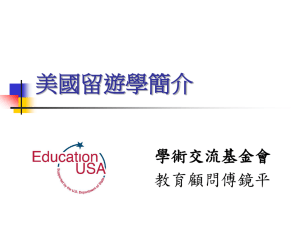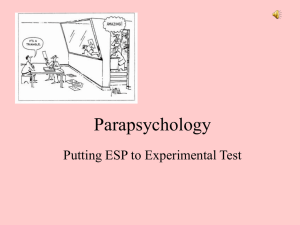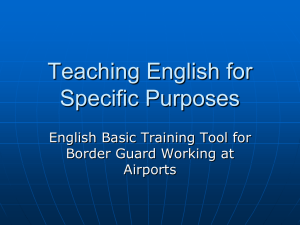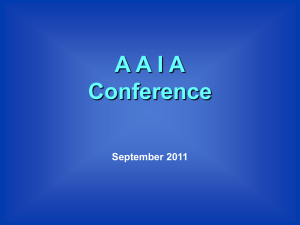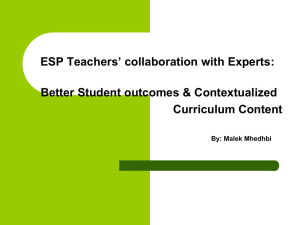ESP
advertisement
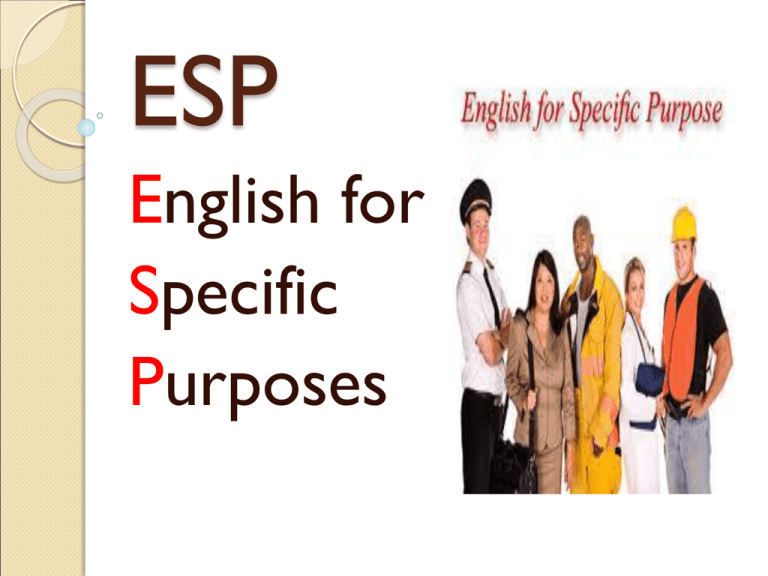
ESP English for Specific Purposes Content of the session 1.What is ESP? 2.The origins of ESP. 3.Characteristics of ESP 4.Types of ESP 5.Some features of ESP courses Content of the session 6.ESP and General English 7.Roles of ESP teachers 8.ESP learner 9.Some ESP organizations and resources 10. Some samples of ESP courses taught in Madinah College Of Technology ( MCT ) What is ESP ? English for Specific Purposes (ESP) is a branch of a wider field, Language for Specific Purposes ( LSP ), which is defined as : “…the area of inquiry and practice in the development of language programs for people who need a language to meet a predictable range of communicative needs.” ( Swales, 1992: 300( What is ESP ? http://en.wikipedia.org/wiki/English_for_s pecific_purposes English for specific purposes From Wikipedia, the free encyclopedia Jump to: navigation, search English for Specific Purposes (ESP), not to be confused with specialized English, is a sphere of teaching English language including Business English, Technical English, Scientific English, English for medical professionals, English for waiters, English for tourism, English for Art Purposes, etc.[1] Aviation English as ESP is taught to pilots, air traffic controllers and civil aviation cadets who are going to use it in radio communications.[2] ESP can be also considered as an avatar of language for specific purposes.[3] What is ESP ? “English for specific purposes is a term that refers to teaching or studying English for a particular career (like law, medicine) or for business in general.“ International Teacher Training Organization, 2005). So, we can say there is a specific reason for learning and teaching English. What is ESP ? ESP is defined as “Goal-oriented language learning” (Robinson and Coleman, 1989 : 398 ) i.e. a specific goal is to be attained. Hutchinson and Waters ( 1987:19) defined ESP as : "an approach to language teaching in which all decisions as to content and method are based on the learner's reason for learning" . Strevens (1988) described it as English language teaching which is designed to meet specified needs of the learner. What is ESP ? ESP is “a major specialization within the discipline of English language teaching”. )Chen 1993 : 80) Still, others specified ESP as the teaching of English for academic studies, or for vocational or professional purposes, as opposed to EGP, (English for general knowledge and skills). (Brunton 2009; Carver, 1983; Hyland, 2006). What is ESP ? we have such acronyms as EAP (English for Academic Purposes) EOP (English for Occupational Purposes) EMP (English for Medical Purposes) EBP (English for Business Purposes) EST (English for Science and Technology) All of these are part of the ELT (English Language Teaching) repertoire. What is ESP ? Whatever name it assumes, ESP is now a term connoting promise for more effective and more useful English language instruction (Tsou, 2009;Yogman & Kaylani, 1996) )Asian ESP Journal Volume 7( What is ESP ? ESP English for Academic Purposes (EAP) Learners: Studying to enter professions, focusing on the language of academic performance in specific discourse communities (and sometimes preparing for near-future identified workplace needs) Fields: Business, Engineering, Medicine, Information Technology, Law, etc. English for Occupational Purposes (EOP) Learners: Employed in industry sectors, focusing on the language of job performance (or preparing for identified employment opportunities) Fields: Industry sectors, government, United Nations, The origins & growth of ESP From the early 1960's, English for Specific Purposes (ESP) has grown to become one of the most prominent areas of EFL teaching today. Its development is reflected in the increasing number of universities offering an MA in ESP and in the number of ESP courses offered to overseas students in English speaking countries. The origins & growth of ESP There is now a well-established international journal dedicated to ESP discussion, "English for Specific Purposes: An International Journal", and the ESP SIG groups of the IATEFL and TESOL are always active at their national conferences. The origins & growth of ESP New developments in educational psychology also contributed to the rise of ESP by emphasizing the central importance of the learners and their attitudes to learning ( e.g. Rodgers,1969) The origins & growth of ESP The origin of ESP and its development is closely linked with learners´ interest in various specific disciplines ,e.g. English for Computing , English for Engineering, English for Business , etc. Students learn English for a specific purposes, represented by studying subject matter, to gain and develop appropriate knowledge and skills through English. The origins & growth of ESP ‘Students study ESP not because they are interested in the English language as such but because they have to perform a task in English. Their command of the English language must be such that they can reach a satisfactory level in their specialist studies.’ )Robinson , 1989 : 396 ). subject The origins & growth of ESP Hutchinson and Waters ( 1992 ) emphasize ESP to be an approach not product that means language learning not language use is highlighted. They draw the attention to a ´learning-centered approach´ “in which all decisions as to content and method are based on the learner´s reason for learning.“ (Hutchinson and Waters, 1992, : 19). The origins & growth of ESP The basic question of ESP is: Why does this learner need to learn a foreign language? The purpose of learning English became the core. The origins & growth of ESP Core Principles of ESP Kevin Knight for TESOL ESP-IS The origins & growth of ESP Swales (1985) uses the development of EST ( English for Science and Technology ) to illustrate the development of ESP in general ‘ with one or two exceptions ........ English for Science and Technology has always set and continues to set a trend in theoretical discussion, in ways of analyzing language and in the variety of teaching materials’. Characteristics of ESP Tony Dudley-Evans and Maggie Jo St John (1998) divided characteristic features of ESP in two groups : 1.absolute characteristics 2.variable characteristics. Absolute characteristics -ESP is defined to meet specific needs of the learner -ESP makes use of the underlying methodology and activities of the discipline it serves -ESP is centered on the language (grammar, lexis, register), skills, discourse and genres appropriate to these activities Variable characteristics · ESP may be related to or designed for specific disciplines · ESP may use, in specific teaching situations, a different methodology from that of general English · ESP is likely to be designed for adult learners, either at a tertiary level institution or in a professional work situation · ESP is generally designed for intermediate or advanced students · Most ESP courses assume some basic knowledge of the language system, but it can be used with beginners (Dudley-Evans, 1998). Characteristics of ESP This classification of ESP characteristics into absolute and variable is, as I think, very useful as it does not include any limitations of learners’ age , ability or any other disciplines. So, ESP is an open ‘approach’ to teaching depending on learners’ needs. "ESP is an approach to language teaching in which all decisions as to content and method are based on the learner's reason learning“. (Hutchinson 1987 : 19) for 4.Types of ESP According to when they take place 1.EAP ( English for Academic Purposes ) 2. EOP ( English for Occupational Purposes) 4.Types of ESP The classification of when and where to use ESP is of argumentative nature. However, trying to capture this ‘fluid nature’ of ESP courses classification, (Duddly-Evans and St.John ,1988) suggest that (ELT) should be a continuum that runs from General English courses to very specific ESP courses as illustrated in table 1 below 6.Some features of ESP courses 1.Organzing course 2. Selecting material 3. Types of activities with text 1.Organzing course To achieve a satisfactory goal, ESP course is to be effectively and consequently organized considering the following factors according to (Hutchinson and Waters, 1992 : 19- 23) 1.The answer to the following questions is a crucial aspect to get ‘language description’ : 1.Organzing course 1-What topic areas will need to be covered? 2-What does the student need to learn? 3-What aspects of language will be needed and how will they be described?......etc. 1.Organzing course 2.The way learning is achieved it is natural that learning strategies vary and corresponds with learners´ groups, their age, level or reason they study. The way adults acquire language is different from children, the group of advanced expects different attitude from beginners and teachers determine which aspects of ESP learning will be focused on to meet learners´ needs and expectations successfully. 1.Organzing course 3.’Needs analysis’ It relates to learner´s surrounding and discusses the questions of ´who´, ´why´, ´where´ and ´when´ connected with the nature of particular target and learning situation. 2. Selecting material Good materials should help the teacher in organizing the course. Materials also are a kind of teacher reflection, ‘they should truly reflect what you think and feel about the learning process’ (Hutchinson and Waters, 1992, : 107). 2. Selecting material Good material should be based on various interesting texts and activities providing a wide range of skills. ‘Teaching materials are tools that can be figuratively cut up into component pieces and then rearranged to suite the needs, abilities, and interests of the students in the course.’ (Graves, 1999, : 27). 2. Selecting material Materials should also function as a link between already learnt ‘existing knowledge’ and new information. (Hutchinson and Waters, 1992). 2. Selecting material Wallace (1992, :91) suggests those main acriteria : ( which can be applied selecting (EGP( ): on Adequacy - should be at the appropriate language, age level. Motivation - should present content which is interesting and motivating for students work. 2. Selecting material Sequence - it is important if there is some relation to previous texts, activities, topics not to miss the sense of a lesson. Diversity - should lead to a range of classroom activities, be a vehicle for teaching specific language structure and vocabulary and promote reading strategies. 2. Selecting material Acceptability - it should accept different cultural customs or taboos. ‘Materials provide a stimulus to learning. Good materials do not teach : they encourage learners to learn.’ (Hutchinson and Waters,1992 : 107 ). 3. Types of activities with text In ESP, text can be a source of new vocabulary or reading skills. Text should be consistent with studying subject matter. Some activities are also suggested to achieve the learning goals( Harmer, 1991: 188 ) like..... 3. Types of activities with text Warm up activities Receptive activates Productive activates Follow-up activities 6.Some features of ESP courses Carver (1983) states that there are three characteristics common to ESP courses: 1.Authentic materials 2.Purpose-related orientation 3.Self-direction 1.Authentic materials -The use of authentic learning materials is possible if we accept the claim that ESP courses should be offered at an intermediate or advanced level. -The use of such materials, modified by teachers or unmodified, is common in ESP, especially in self-directed studies or research tasks. 1.Authentic materials The students are usually encouraged to conduct research using a variety of different resources including the Internet 2.Purpose-related orientation -Refers to the simulation of communicative tasks required by the target situation. -The teacher can give students different tasks - to simulate the conference preparation, involving the preparation of papers, reading, note-taking and writing. 3.Self-direction -It means that ESP is concerned with turning learners into users. -For self - direction, it is necessary that teacher encourages students to have a certain degree of autonomy – freedom to decide when, what, and how they will study. -For high-ability learners it is essential to learn how to access information in a new culture. 9.ESP and General English Question: ‘What is the difference between the ESP and General English approach?’ Answer: ‘In theory nothing, in practice a great deal’. (Hutchinson,1987: 53) In 1987, the last statement might be quite true but teachers nowadays, however, are much more aware of the importance of needs analysis, and published textbooks have improved dramatically allowing the teacher to select materials which closely match the goals of the learner. 7.Roles of ESP teachers 1.To meet the learners’ specific needs in the field of particular discipline . 2.To provide satisfying learning background (designing course, setting goals and objectives, selecting material etc.) ‘ESP teacher should not become a teacher of the subject matter, but rather an interested student of the subject of the subject matter’ (Hutchinson and Waters, 1992 : 163). 7.Roles of ESP teachers Hutchinson and Waters (1992) stress two roles differ between ´ESP´ and ´General English´ teacher. Beside the typical duties of classroom teacher, ESP teacher “deals with needs analysis, syllabus design, materials writing or adaption[sic] and evaluation,“ they see “ESP teacher´s role in one of many parts.“ (Hutchinson and Waters, 1992: 157). 7.Roles of ESP teachers teachers of ESP have to “orientate themselves to a new environment.” (Hutchinson & Waters, 1992 : 157 ). 7.Roles of ESP teachers ESP professionals, due to their industrial /communication expertise, often have multiple roles in the public, private and academic sectors on a local, regional, or global scale including: − Teaching or training (onsite and/or online) − Teacher or trainer development (onsite and/or online) − Curriculum design − Consulting 7.Roles of ESP teachers − Materials development − Program administration − Policy analysis and development − Public speaking − Research Kevin Knight for TESOL ESP-IS 7.Roles of ESP teachers Dudley Evans theory of ESP practitioner: Tony Dudley Evans and St John (1998) define five key roles: 1.teacher 2. collaborator 3. course designer and materials provider 4. researcher 5. evaluator ESP learners ESP learners can be divided according to their need for English communication skills. 1.Language learners who are in the process of developing expertise in their fields need English communication skills as tools in their training. ESP learners 2.Language learners who are already experts in their fields need English communication skills as tools in their work. Adapted from © Lomperis and van Naerssen, 1992 Some ESP organizations ESP organizations/communities exist at local, regional, and global levels. The websites of these organizations may provide links to other organizations, journals/periodicals, examinations, and online resources Some ESP organizations ESP organizations include − TESOL (Teachers of English to Speakers of Other Languages) ESP-IS (Interest Section ) − IATEFL (International Association of Teachers of English as a Foreign Language) ESP SIG (Special Interest Group) − IATEFL BE (Business English) SIG − Asia-Pacific LSP (Language for Specific Purposes) and Professional Communication Association − (TESPA) Taiwan ESP Association Some ESP organizations ESP professionals are also active in many other professional organizations including : − ASTD (American Society for Training and Development) − EASE (European Association of Science Editors) − IEEE (Institute of Electrical and Electronic Engineers) − IFTDO (International Federation of Training and Development Organizations) Some ESP organizations -The British Association of Lecturers in English for Academic Purposes http://www.baleap.org.uk -The British Association of Applied Linguistics http://www.baal.org.uk -ESP Interest Section of TESOL US http://www2.tesol.org/communities/espis/rules.html ESP SIG TESOL Greece http://www.tesolgreece.com/eap_esp.html Some ESP organizations ESP SIG of Michigan Teachers of ESOL http://www.etas.ch/etas/people/list.asp?lPTY_Id=3#SESP )Journal of ESP (Elsevier Publications http://www.elsevier.com/wps/find/journaldescription .cws_home/682/description#description Journal of EAP (Elsevier http://www.elsevier.com/wps/find/journaldescription .cws_home/622440/description#description Some ESP organizations Asian ESP Journal http://www.asian-esp-journal.com Sample of ESP courses in MCT More details will be presented in PDF files Thank you for listening Khalid B. Aljohani English Language Instructor Colloge of Technology Kingdom of Saudi Arabia Madinah Munawarah kbs444@hotmail.com

